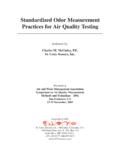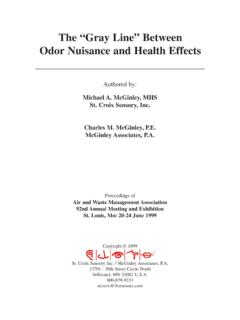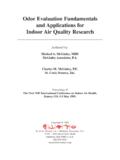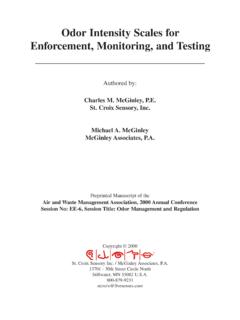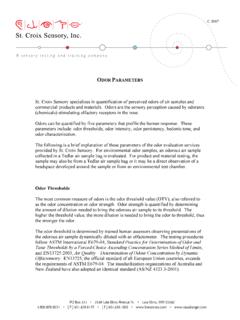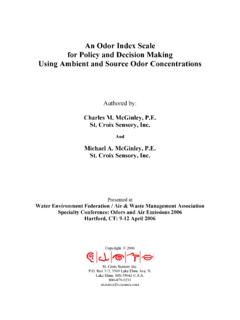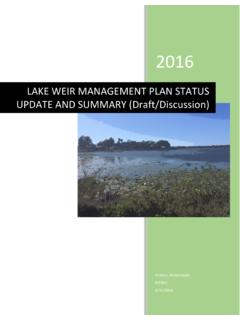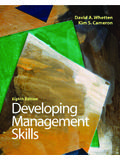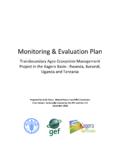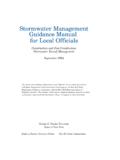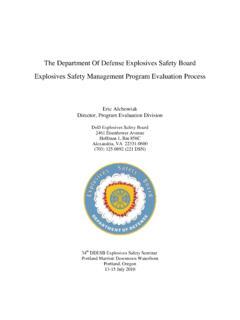Transcription of Developing a Credible Odor Monitoring Program
1 Developing a Credible Odor Monitoring Program Authored by: Michael A. McGinley, St. Croix Sensory, Inc. And Charles M. McGinley, St. Croix Sensory, Inc. Proceedings of American Society of Agricultural Engineers (ASAE) 2004 Annual Conference Ottawa, ON, Canada: 1-4 August 2004 Abridged version also presented at VDI International Conference: Environmental Odour Management K ln, Germany : 17-19 November 2004 Copyright 2004 St. Croix Sensory Inc. / McGinley Associates, Box 313, 3549 Lake Elmo Ave. N. Lake Elmo, MN 55042 800-879-9231 The authors are solely responsible for the content of this technical presentation. The technical presentation does not necessarily reflect the official position of ASAE or CSAE, and its printing and distribution does not constitute an endorsement of views which may be expressed.
2 Technical presentations are not subject to the formal peer review process, therefore, they are not to be presented as refereed publications. Citation of this work should state that it is from an ASAE/CSAE meeting paper. EXAMPLE: Author's Last Name, Initials. 2004. Title of Presentation. ASAE/CSAE Meeting Paper No. 04xxxx. St. Joseph, Mich.: ASAE. For information about securing permission to reprint or reproduce a technical presentation, please contact ASAE at or 269-429-0300 (2950 Niles Road, St. Joseph, MI 49085-9659 USA). An ASAE/CSAE Meeting Presentation Paper Number: 042201 Developing a Credible Odor Monitoring Program Michael A. McGinley, St. Croix Sensory, Inc., Box 313, 3549 Lake Elmo Ave. N., Lake Elmo, MN 55042, Charles M.
3 McGinley, St. Croix Sensory, Inc., Box 313, 3549 Lake Elmo Ave. N., Lake Elmo, MN 55042, Written for presentation at the 2004 ASAE/CSAE Annual International Meeting Sponsored by ASAE/CSAE Fairmont Chateau Laurier, The Westin, Government Centre Ottawa, Ontario, Canada 1 - 4 August 2004 Abstract. Odors are the cause for most air pollution complaints reported by citizens living near livestock facilities. In communities across the country odor issues are addressed in a variety of ways. Often odor regulations and ordinances place a limit on the strength of ambient odor. The strength of odor in the ambient air is measurable using either a 1-butanol intensity referencing scale or a Scentometer (field olfactometer) device. These standard methods and procedures can be utilized by facility personnel to conduct proactive odor Monitoring .
4 A Credible odor Monitoring Program must begin with proper training of odor observers (inspectors or investigators). This training must prepare the observer to make observations in accordance with standard procedures and to record pertinent information in a standard, clear format. The trained odor observers must also be provided with an understanding of how to prepare and present the Monitoring reports to supervisors, facility managers, officials, and the general public. This paper will discuss the following topics: 1) elements of an odor Monitoring plan, 2) odor observer training, 3) odor observer sensitivity testing, and 4) standard methods and practices for objectively quantifying ambient odors. This paper will present case studies of odor Monitoring programs in the and Canada. Results of these case studies will be discussed along with a discussion of the benefits of the Program in each specific case.
5 Keywords. Odor, odour, Monitoring , olfactometry, Scentometer, training, CAFO s, environmental 2 Frequency Introduction Odors are the cause for most air pollution complaints reported by citizens living near odorous facilities, such as wastewater treatment plants, landfills, composting operations, food & byproduct processes, factories, and agricultural activities, livestock facilities. A conceptual model for what makes an odor episode become a citizen complaint is the Citizen Complaint Pyramid, shown in Figure 1. Four parameters make up the hierarchy in this pyramid: 1) character/offensiveness, 2) strength, 3) duration, and 4) frequency. The character of the odor is the actual description of what the odor smells like. This parameter is sometimes called the quality or offensiveness of the odor. Strength of the odor refers to the overall intensity or concentration of the odor.
6 The stronger the odor, the more likely a citizen is to be annoyed. Even pleasant odors, such as perfumes, can be annoying at high odor strength. Duration is the elapsed time of each odor episode. Longer duration odor episodes can lead to more drastic changes in plans around a citizen s home or community. Episodes of very short duration may be over before a citizen changes plans. Finally, frequency refers to how often the citizen experiences odor episodes. The more frequent the intrusion into the citizen s life, the more annoying each experience becomes. The cumulative effect of these four parameters: character, strength, duration, frequency creates the nuisance experience and the likely citizen complaint. This conceptual model helps define odor episodes and assists in the development of a Credible odor Monitoring Program . Odor Monitoring Program Components A Credible odor Monitoring Program requires four main components: 1) qualified odor observers (trained inspectors/investigators), 2) objective observational methods (how to describe and measure odors), 3) standard Monitoring practices (routine survey/inspection routes), and 4) standard data collection and reporting forms.
7 The Odor Episode Character / OffensivenessDurationStrength Figure 1. The Citizen Complain Pyramid 3 Qualified Odor Observers Any odor Monitoring Program must first start with available personnel becoming odor observers. These personnel must receive training related to odors and odor observation. The essential elements of the training curriculum provides the students with a basic understanding and working knowledge of nasal anatomy, odor chemistry, odor parameters, odor observation techniques, meteorology, standard field procedures and documentation formats (McGinley, et al, 1995). The training prepares the odor observer to be consistent in observations and to be aware of and adjust to variable field conditions. An odor observer s olfactory sensitivity is a factor in making observations of odor strength in the ambient air. A standardized nasal chemosensory test method determines the olfactory threshold of an individual and allows comparison of the individual s olfactory sensitivity to normative values.
8 In the routine clinical evaluation of patients with olfactory disorders, one commercially available psychophysical testing method is known as Sniffin Sticks, shown in Figure 2. Sniffin Sticks, manufactured by Burghart of Germany, are non-dispensing felt tip marker pens. One nasal chemosensory testing mode can determine a person s odor threshold based on the standard odorant 1-butanol. Figure 2. The St. Croix Sensory Odor Pen Testing Kit, manufactured by Burghart. Included in the kit are a blindfold, latex gloves, and the set of 14 odor pens (red) and two blank pens. It is assumed that olfactory sensitivity varies as a result of random fluctuations in factors such as alertness, attention, fatigue, health status, and the possibility of variable presentation techniques of the testing stimulus source. Even though the determination of an individual s olfactory threshold is a one-time testing task, the precision of the result is based on the number of times the individual takes a test.
9 Therefore, it is recommended that each odor observer be tested once to learn the testing procedure , then tested three times within one month to establish a base line for the observer, and to continue testing monthly to establish a cumulative ( Monitoring Program ) average for the observer. Note that an individual s general condition of health, common cold and seasonal allergies, needs to be considered in the timing and applicability of the testing. The results of a published multi-clinic investigation of 1,000 subjects (Kobal, et. al., 2000) and a published study of state agency personnel (Lay, et. al., 2004) provide normative values for the general population and can be used to develop performance criteria for field odor observers. In general, the Sniffin Sticks odor pen Number 8 represents the 50%tile of the general population and odor pens Number 3 and 13 represent the lower 5%tile and upper 5%tile of the general population, respectively.
10 4 Objective Observational Methods Trained odor observers need to describe and measure ambient odors using standard terminology and measurement practices. When the odor observers are proficient in quantifying (describing and measuring) ambient odors the odor Monitoring Program will be successful and Credible . Odor Descriptors Odors can be objectively described using standard categories and a standard reference vocabulary. A standard practice for odor description is to provide observers with a standard list of descriptor terms, which are organized with like terms in categories or groups (Harper, 1968). In the 1970 s American and British brewing and sensory scientists developed a Beer Flavor Wheel as a tiered system for describing the flavor (taste and odor) of beers (Meilgaard, et. al., 1982). In the 1980 s, the California wine industry developed a wine aroma wheel for the characterization of wines (Noble, 1984).
